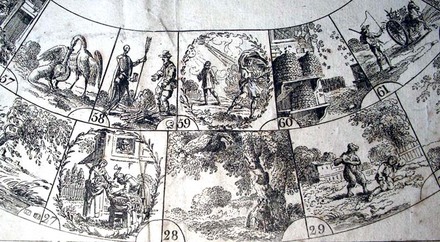This is an early nineteenth-century version of the Game of the Goose, which is claimed to have been a gift from Francesco I de’ Medici, Grand Duke of Tuscany (1541-1613) to King Philip II of Spain (1527-1598) sometime between 1574 and 1587. According to H. J. R. Murray, A History of Board-Games Other than Chess (Firestone GV1312 .M8 1952), the Game of the Goose reached England by 1597, when John Wolfe entered “the newe and most pleasant game of the Goose” in the Stationers’ Register.
No matter what the theme, the board consists of sixty-three numbered spaces arranged in a spiral. In La prix de sagesse each of the numbered compartments depicts a fable from Jean de La Fontaine (1621-1695), arranged around a center square. Rules are also given in English, along with brief summaries of the fables in verse to left and to right.
The French poet La Fontaine published 243 fables in twelve books from 1668 to 1694. He took his inspiration from Aesop, Horace, and ancient Indian literature such as the Panchatantra. The first collection of Fables Choisies (Ex 3262.33.173) appeared March 31, 1668, dedicated to “Monseigneur” Louis de France (1661-1711) the six-year-old son and heir of Louis XIV, King of France and Maria Theresa of Spain.
Rare Books and Special Collections holds more than 150 editions of La Fontaine’s Fables. The Cotsen collection holds over two dozen different versions of the Game of the Goose, included a variant edition of the La Fontaine: Jeu instructif des Fables de la Fontaine (Paris: Basset [between 1835 and 1845]). (CTSN) Print Case LA / Box 99 103446
For English translations of the fables, see http://oaks.nvg.org/fontaine.html



